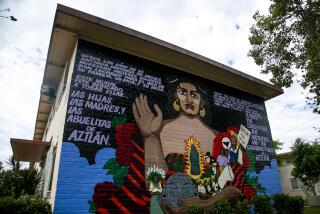Arizona bill takes aim at ethnic studies classes
- Share via
Reporting from Tucson and Los Angeles — At the main entrance to a campus in Tucson, a sign greets visitors with “Welcome to Tucson High, Home of the Largest Xicano Studies Program in the Nation.”
“Xicano,” or Chicano, studies is a 14-year-old program in the Tucson Unified School District that offers classes from elementary through high school in topics such as literature, history and social justice that emphasize Latino authors and history.
In the wake of Arizona’s adoption of a law to crack down on illegal immigration, such classes are the subject of another ethnically tinged fight in the state. Another bill approved by the Legislature seeks to ban such courses, which critics say promote “ethnic chauvinism.”
Supporters of Mexican American studies say the aim is to offer subjects and perspectives ignored by academia, as well as foster pride in a marginalized community.
In teacher Curtis Acosta’s literature class at Tucson High, the walls are plastered with the faces of labor leaders Cesar Chavez and Dolores Huerta and Latin American revolutionary Che Guevara. Students read fiction by Luis Alberto Urrea and Junot Diaz and plays by the Los Angeles-based theater troupe Culture Clash. A poster proclaims “United Together En La Lucha”—In The Struggle.
The proposed law would ban schools from teaching classes that promote the overthrow of the U.S. government, are designed for students of a particular ethnic group, promote resentment or advocate ethnic solidarity over treating pupils as individuals.
The Tucson district says its program doesn’t do any of those things. Sean Arce, the program’s director, said the classes are a way to address the academic achievement gap between Latinos and non-Latinos.
“Why aren’t these legislators up in arms that we have this huge Latino population going to prison and not to higher education?” he asked. “They should be outraged about that. They should be saying, ‘What can we do to fix that?’ But they’re not.”
Ethnic studies are taught at high schools and colleges, but district officials say their program is unique because it’s districtwide, offered to grades K-12 and can satisfy high school graduation requirements. About 3% of the district’s 55,000 students take Mexican American studies.
The program has been targeted before.
In June 2007, Tom Horne, the Arizona superintendent of public instruction, wrote an open letter to the residents of Tucson, outlining objections to the program. Horne, who said he participated in the civil rights marches in the summer of 1963, invoked the Rev. Martin Luther King Jr. in saying people should be judged by the content of their character rather than the color of their skin.
Last year, a bill to ban such classes moved through the Legislature but stalled. Now, HB 2281 sits on Gov. Jan Brewer’s desk. She has until May 11 to veto or sign it. If she does nothing, the bill becomes law.
Augustine Romero, the director of student equity for the Tucson district, said it has become politically acceptable to attack Latinos in Arizona. Horne is running for state attorney general, and Romero accused him of using the issue to garner popularity.
Romero said none of the implied criticisms in the bill can be attributed to the district’s classes. “In terms of how it’s written, it shouldn’t have any impact on us whatsoever,” he said.
In Acosta’s literature class, he turned debate over HB 2281 into a lesson, reading from a newspaper article about the bill and quoting comments posted by readers. “To me this is plain sedition,” one reader wrote of ethnic studies. “Not only is this un-American, but I think those in charge of this should be arrested for being traitors to our country.”
“What is sedition?” Acosta asked. “Anybody? Anybody know?”
“It’s like treason,” someone said.
Acosta, like many teachers, often tailors lesson plans and his approach to his audience. Acosta, who wears thick black-rimmed glasses, a white shirt and tie, often calls his students mija and mijo (my daughter/son), and this week he handed out copies the acclaimed Sandra Cisneros short story “Woman Hollering Creek.”
The students broke into groups to discuss the story about a recently married woman who leaves her father’s home. “I want you to tell me what it makes you feel. I want you to get back into feeling,” he said. “Literature is art, man. That’s why I love teaching it.”
“It reminds me of when I’m at home alone doing nothing and you just hear the sounds around you,” Leana Abril, 17, told her group.
“Kind of like loneliness,” another student said.
Later, after the bell rang, Leana explained why she’s taking the course.
“I thought it’d be more interesting to have a different perspective on learning literature,” she said. “It’s like literature with a heart, more than just academic. In this class it’s like our goal to better ourselves, to better the community.”
More to Read
Sign up for Essential California
The most important California stories and recommendations in your inbox every morning.
You may occasionally receive promotional content from the Los Angeles Times.














